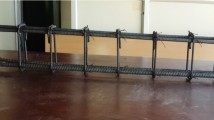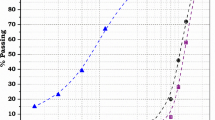Abstract
Waste slag from the metallurgical industry such as ferronickel slag (FNS) is a promising material to replace natural sand (NS) in the production of sustainable concrete. This study experimentally investigated the performance of concrete containing 50% FNS as well as the replacement of 15 and 30% of cement with FA by determining the slump, density, and axial stress–strain behavior under compression load. Furthermore, an accelerated corrosion test was conducted by subjecting the reinforced concrete specimens to a 3% NaCl solution and a constant voltage of 10 V up to 240 h in order to evaluate their corrosion resistance performance. The test results showed that the slump and density of concrete increased due to the presence of FNS and FA compared to the control concrete. It was discovered that all the specimens expressed linear behaviors till when the peak stress was reached under compression load. Moreover, the peak stress, peak strain, modulus of elasticity, and toughness of FNS-FA concretes are higher than the values for the control concrete but their ultimate strain is lower at approximately 12.27–17.59%, thereby, indicating the brittleness of FNS-FA concretes. The findings also showed that concrete considered to be durable against corrosion can be produced using 50% FNS and 30% FA with approximately 1.4 and 2.2 times longer initial time to first cracking and lower weight loss, respectively, than the control specimen. Therefore, the concrete mixture of 50%FNS-30%FA is a viable option in designing sustainable concrete structures exposed to a chloride environment.



















Similar content being viewed by others
References
ISO-ISO/TC 71 (2020) Concrete, reinforced concrete and pre-stressed concrete (n.d.). https://www.iso.org/committee/49898.html. Accessed 28 Jun 2022
Saha AK, Khan MNN, Sarker PK (2018) Value added utilization of by-product electric furnace ferronickel slag as construction materials: a review. Resour Conserv Recycl 134:10–24. https://doi.org/10.1016/J.RESCONREC.2018.02.034
Sun J, Feng J, Chen Z (2019) Effect of ferronickel slag as fine aggregate on properties of concrete. Constr Build Mater 206:201–209. https://doi.org/10.1016/J.CONBUILDMAT.2019.01.187
Seetao (2021) The global sand consumption is huge, and the resources are facing exhaustion—seetao (n.d.). https://www.seetao.com/details/70499.html. Accessed 28 Jun 2022
Mamdouh A, AziziSafiee N, Hejazi F, Azarkerdar A (2019) Application of waste from steel industry to construction material: a review. IOP Conf Ser Earth Environ Sci 357:012026. https://doi.org/10.1088/1755-1315/357/1/012026
Edwin RS, Kimsan M, Pramono B et al (2022) Effect of ferronickel slag in concrete and mortar. Mag Civ Eng 109:10909–10909. https://doi.org/10.34910/MCE.109.9
Liu Y, Su Y, Xu G et al (2022) Research progress on controlled low-strength materials: metallurgical waste slag as cementitious materials. Mater 15(3):727. https://doi.org/10.3390/MA15030727
Peng Z, Gu F, Zhang Y et al (2018) Chromium: a double-edged sword in preparation of refractory materials from ferronickel slag. ACS Sustain Chem Eng 6:10536–10544. https://doi.org/10.1021/ACSSUSCHEMENG.8B01882/ASSET/IMAGES/MEDIUM/SC-2018-018828_0010.GIF
Kementerian ESDM RI-site (n.d.). https://www.esdm.go.id/. Accessed 3 Jul 2022
Gencel O, Karadag O, Oren OH, Bilir T (2021) Steel slag and its applications in cement and concrete technology: a review. Constr Build Mater 283:122783. https://doi.org/10.1016/J.CONBUILDMAT.2021.122783
Fares AI, Sohel KMA, Al-Jabri K, Al-Mamun A (2021) Characteristics of ferrochrome slag aggregate and its uses as a green material in concrete—a review. Constr Build Mater 294:123552. https://doi.org/10.1016/J.CONBUILDMAT.2021.123552
Caronge M et al (2015) Application of sacrificial point anode for prevention of steel corrosion in cracked concrete. J Adv Concr Technol 13(10):479–488. https://doi.org/10.3151/JACT.13.479
Aggelis DG, Kordatos EZ, Soulioti DV, Matikas TE (2010) Combined use of thermography and ultrasound for the characterization of subsurface cracks in concrete. Constr Build Mater 24(10):1888–1897. https://doi.org/10.1016/J.CONBUILDMAT.2010.04.014
Liu H, Zhong J, Ding F, Meng X, Liu C, Cui J (2022) Detection of early-stage rebar corrosion using a polarimetric ground penetrating radar system. Constr Build Mater 317:125768. https://doi.org/10.1016/J.CONBUILDMAT.2021.125768
Dong B et al (2018) Visualized tracing of rebar corrosion evolution in concrete with x-ray micro-computed tomography method. Cem Concr Compos 92:102–109. https://doi.org/10.1016/J.CEMCONCOMP.2018.06.003
Fan L, Tan X, Zhang Q, Meng W, Chen G, Bao Y (2020) Monitoring corrosion of steel bars in reinforced concrete based on helix strains measured from a distributed fiber optic sensor. Eng Struct 204:110039. https://doi.org/10.1016/J.ENGSTRUCT.2019.110039
Toongoenthong K, Maekawa K (2004) Interaction of pre-induced damages along main reinforcement and diagonal shear in RC members. J Adv Concr Technol 2(3):431–443. https://doi.org/10.3151/JACT.2.431
Tang H, Peng Z, Gu F, et al (2021) Utilization of ferronickel slag for producing concrete. In: Characterization of minerals, metals, and materials, 211–219. https://doi.org/10.1007/978-3-030-65493-1_20
Petrounias P, Rogkala A, Giannakopoulou PP et al (2022) Utilization of industrial ferronickel slags as recycled concrete aggregates. Appl Sci 12:2231. https://doi.org/10.3390/APP12042231
Małek M, Jackowski M, Łasica W et al (2021) An experimental study of possible post-war ferronickel slag waste disposal in Szklary (Lower Silesian, Poland) as partial aggregate substitute in concrete: characterization of physical, mechanical, and thermal properties. Materials 14:2552. https://doi.org/10.3390/MA14102552
Saha AK, Sarker PK (2017) Sustainable use of ferronickel slag fine aggregate and fly ash in structural concrete: mechanical properties and leaching study. J Clean Prod 162:438–448. https://doi.org/10.1016/J.JCLEPRO.2017.06.035
Liu X, Li T, Tian W et al (2020) Study on the durability of concrete with FNS fine aggregate. J Hazard Mater 381:120936. https://doi.org/10.1016/J.JHAZMAT.2019.120936
Katsiotis NS, Tsakiridis PE, Velissariou D et al (2015) Utilization of ferronickel slag as additive in Portland cement: a hydration leaching study. Waste Biomass Valoriz 62(6):177–189. https://doi.org/10.1007/S12649-015-9346-7
Demotica JS, Amparado RF Jr, Malaluan RM, Demayo CG (2012) Characterization and leaching assessment of ferronickel slag from a smelting plant in Iligan City. Philippines Int J Environ Sci Dev. https://doi.org/10.7763/IJESD.2012.V3.269
Choi YC, Choi S (2015) Alkali–silica reactivity of cementitious materials using ferro-nickel slag fine aggregates produced in different cooling conditions. Constr Build Mater 99:279–287. https://doi.org/10.1016/J.CONBUILDMAT.2015.09.039
Saha AK, Sarker PK (2016) Expansion due to alkali–silica reaction of ferronickel slag fine aggregate in OPC and blended cement mortars. Constr Build Mater 123:135–142. https://doi.org/10.1016/J.CONBUILDMAT.2016.06.144
Thompson A, Saha AK, Sarker PK (2019) Comparison of the alkali–silica reactions of ferronickel slag aggregate in fly ash geopolymer and cement mortars. Eur J Environ Civ Eng 26:891–904. https://doi.org/10.1080/19648189.2019.1686068
Maysyurah A, Caronge MA (2022) Point load test method for prediction strength of sustainable mortar made from blended cement and fly ash. IOP Conf Ser Earth Environ Sci 1117(1):012029. https://doi.org/10.1088/1755-1315/1117/1/012029
Caronge MA, Tjaronge MW, Rahim IR et al (2022) Feasibility study on the use of processed waste tea ash as cement replacement for sustainable concrete production. J Build Eng 52:104458. https://doi.org/10.1016/J.JOBE.2022.104458
Krauss P, Paret T (2014) Review of properties of concrete, 5th ed., by A. M. Neville. J Perform Constr Facil 28(3):630–630. https://doi.org/10.1061/(ASCE)CF.1943-5509.0000595
Shoya M, Sugita S, Tsukinaga T, Aba M, Tokuhasi K (1999) Properties of self-compacting concrete with slag fine aggregates. Exploiting wastes in concrete. University of Dundee, Scotland, pp 121–130
Saha AK, Sarker PK (2020) Effect of sulphate exposure on mortar consisting of ferronickel slag aggregate and supplementary cementitious materials. J Build Eng 28:101012. https://doi.org/10.1016/J.JOBE.2019.101012
Nuruzzaman M, Camargo Casimiro JO, Sarker PK (2020) Fresh and hardened properties of high strength self-compacting concrete using by-product ferronickel slag fine aggregate. J Build Eng 32:101686. https://doi.org/10.1016/J.JOBE.2020.101686
Nguyen QD, Castel A, Kim T, Khan MSH (2021) Performance of fly ash concrete with ferronickel slag fine aggregate against alkali–silica reaction and chloride diffusion. Cem Concr Res 139:106265. https://doi.org/10.1016/J.CEMCONRES.2020.106265
Nguyen QD, Khan MSH, Castel A, Kim T (2019) Durability and microstructure properties of low-carbon concrete incorporating ferronickel slag sand and fly ash. J Mater Civ Eng 31:04019152. https://doi.org/10.1061/(ASCE)MT.1943-5533.0002797
ASTM C618-19 (2019) Standard specification for coal fly ash and raw or calcined natural pozzolan for use in concrete, ASTM international, West Conshohocken, PA, www.astm.org
ASTM C128-15 (2015) Standard test method for relative density (specific gravity) and absorption of fine aggregate, ASTM international, West Conshohocken, PA, www.astm.org
ASTM C136-06 (2006) Standard test method for sieve analysis of fine and coarse aggregates, ASTM international, West Conshohocken, PA, www.astm.org
SNI 15-3500-2004 (2004) Portland blended cement, Indonesian national standar (SNI), Jakarta, Indonesia (in Bahasa)
ASTM C143-78 (2019) Standard test method for slump of portland cement concrete, ASTM international, West Conshohocken, PA, www.astm.org
ASTM C642-21 (2021) Standard test method for density, absorption, and voids in hardened concrete, ASTM international, West Conshohocken, PA, www.astm.org
SNI 1974:2011 (2011) Method for compressive strength of concrete with a cylindrical specimen, Indonesian national standar (SNI), Jakarta, Indonesia (in Bahasa)
ASTM C469-14 (2014) Standard test method for static modulus of elasticity and poisson’s ratio of concrete in compression, ASTM international, West Conshohocken, PA, www.astm.org
Al-Swaidani AM, Aliyan SD (2015) Effect of adding scoria as cement replacement on durability-related properties. Int J Concr Struct Mater 9:241–254. https://doi.org/10.1007/S40069-015-0101-Z/FIGURES/15
Hussain SE, Rasheeduzzafar (1994) Corrosion resistance performance of fly ash blended cement concrete. Mater J 91(3):264–272. https://doi.org/10.14359/4332
Uysal M, Akyuncu V (2012) Durability performance of concrete incorporating class F and class C fly ashes. Constr Build Mater 34:170–178. https://doi.org/10.1016/J.CONBUILDMAT.2012.02.075
Togawa K, Shoya M, Kokubu K (1996) Characteristics of bleeding, freeze-thaw resistance and watertightness of concrete with ferro-nickel slag fine aggregates. J Soc Mater Sci Jpn 45(1):101–109. https://doi.org/10.2472/jsms.45.101
Sato T (2011) Influence of excessive bleeding on frost susceptibility of concrete incorporating influence of excessive bleeding on frost susceptibility of concrete incorporating. In: 36th conference on our world in concrete & structures
Neville AM (2011) Properties of concrete, 5th edition. Pearson
Abusaleem M, Zhuge Y, Hassanli R et al (2021) Stress-strain behaviour and mechanical strengths of concrete incorporating mixed recycled plastics. J Compos Sci 5:146. https://doi.org/10.3390/JCS5060146
Sakoi Y, Aba M, Tsukinaga Y, Nagataki S (2013) Properties of concrete used in ferronickel slag aggregate. In: Proceedings of the 3rd international conference on sustainable construction materials and technologies. Tokyo, Japan, pp 1–6
de Schutter G, Audenaert K (2004) Evaluation of water absorption of concrete as a measure for resistance against carbonation and chloride migration. Mater Struct 37(9):591–596. https://doi.org/10.1007/BF02483288
Reddy DV, Edouard JB, Sobhan K, Rajpathak SS (2011) Durability of reinforced fly ash-based geopolymer concrete in the marine environment. In: Proceedings of the 36th conference on our world in concrete & structures, August 14–16, Singapore
Abosrra L, Ashour AF, Youseffi M (2011) Corrosion of steel reinforcement in concrete of different compressive strengths. Constr Build Mater 25:3915–3925. https://doi.org/10.1016/J.CONBUILDMAT.2011.04.023
Boa AR, Topu LB (2012) Influence of fly ash on corrosion resistance and chloride ion permeability of concrete. Constr Build Mater 31:258–264. https://doi.org/10.1016/J.CONBUILDMAT.2011.12.106
Zafar I, Alqahtani FK (2021) Effectiveness of extended curing for fly ash concrete against corrosion propagation under severe chloride exposure. Struct Concr 22:2688–2703. https://doi.org/10.1002/SUCO.202000614
Sandra N, Kawaai K, Ujike I (2021) Effect of copper slag fine aggregate on corrosion processes and behavior in reinforced concrete prism specimen. Constr Build Mater 271:121909. https://doi.org/10.1016/J.CONBUILDMAT.2020.121909
Al-Yaqout A, El-Hawary M, Nouh K, Khan PB (2020) Corrosion resistance of recycled aggregate concrete incorporating slag. Mater J 117:111–222. https://doi.org/10.14359/51722406
Vitharana MG, Paul SC, Kong SY et al (2020) A study on strength and corrosion protection of cement mortar with the inclusion of nanomaterials. Sustain Mater Technol 25:e00192. https://doi.org/10.1016/J.SUSMAT.2020.E00192
Jung SH, Saraswathy V, Karthick S, Kathirvel P, Kwon SJ (2018) Microstructure characteristics of fly ash concrete with rice husk ash and lime stone powder. Int J Concr Struct Mater 12(1):1–9. https://doi.org/10.1186/S40069-018-0257-4
Popławski J, Lelusz M (2023) Assessment of sieving as a mean to increase utilization rate of biomass fly ash in cement-based composites. Appl Sci 13(3):1659. https://doi.org/10.3390/APP13031659
Sheng G, Li Q, Zhai J, Li F (2007) Self-cementitious properties of fly ashes from CFBC boilers co-firing coal and high-sulphur petroleum coke. Cem Concr Res 37(6):871–876. https://doi.org/10.1016/J.CEMCONRES.2007.03.013
Ohenoja K et al (2016) Self-hardening of fly ashes from a bubbling fluidized bed combustion of peat, forest industry residuals, and wastes. Fuel 165:440–446. https://doi.org/10.1016/J.FUEL.2015.10.093
Author information
Authors and Affiliations
Corresponding author
Ethics declarations
Conflict of interest
The authors have no competing interests to declare that are relevant to the content of this article.
Ethical approval
Not applicable.
Informed consent
Not applicable.
Rights and permissions
Springer Nature or its licensor (e.g. a society or other partner) holds exclusive rights to this article under a publishing agreement with the author(s) or other rightsholder(s); author self-archiving of the accepted manuscript version of this article is solely governed by the terms of such publishing agreement and applicable law.
About this article
Cite this article
Irmawaty, R., Caronge, M.A., Tjaronge, M.W. et al. Compressive strength and corrosion behavior of steel bars embedded in concrete produced with ferronickel slag aggregate and fly ash: an experimental study. Innov. Infrastruct. Solut. 8, 200 (2023). https://doi.org/10.1007/s41062-023-01162-1
Received:
Accepted:
Published:
DOI: https://doi.org/10.1007/s41062-023-01162-1




